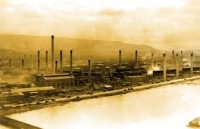WGA In-Person Luncheon ~ Bob King, History of the Casper Amoco Refinery Site

Abstract
Casper Wyoming’s Standard Oil Refinery – A Resource Reborn
Robert A. (Bob) King
1551 Three Crowns Drive, Suite 301
Casper, Wyoming 82604
Standard Oil of Indiana’s oil refinery along the North Platte River in Casper operated from 1912 through 1991, and was the lifeblood of Casper’s economy for 80 years. First operated by Midwest Refining Company to process Salt Creek Field oil, by the early 1920s it had a capacity of 55,000 barrels per day and was the largest gasoline producing refinery in the world. Standard took ownership of the facility by the late 1920s and operated under the Amoco name in 1972.
In late 1991 Amoco announced it was closing the refinery due to projected costs to meet present and future regulatory requirements, its age and small size, marginal performance, and decreasing crude availability. Throughput had decreased to about 28,000 barrels per day. The closing caused consternation within the community, fearful the site would become an eyesore that would remain unused for the foreseeable future. A citizens group came together to work with Amoco, regulatory agencies overseeing environmental concerns, city and county officials, and the public to propose an expedited plan to return the sites to beneficial use in a timely manner.
Negotiations were undertaken to develop a collaborative process whereby Amoco, the Wyoming Department of Environmental Quality, the Environmental Protection Agency, state and local government, and the public worked together to reach protective, reasonable and timely decisions for the cleanup and reuse of the site. A reuse agreement was reached between Amoco, the City of Casper, and Natrona County, and the collaborative process was overseen by a city/county joint powers board. Wyoming’s Legislature passed a Brownfields Law allowing remediation based on restricted land use. Design standards and a corrective action plan were developed, and Amoco implemented a program to clean up the sites to remediate soil and water contamination from an estimated 30 million gallons of hydrocarbon by-products spilled during the refinery’s 80 years of operation.
The final reuse plan included a golf course, kayak course, river-park with picnic areas, bicycle and walking trails, business and industrial parks with utilities infrastructure, new roadways, and renovation of the refinery administrative building. No residential housing would be permitted, and Amoco would provide funding packages to the city/county for operation and maintenance, economic development, and building and facilities development both on and off-site. Amoco transferred most of its water rights to the city and county, and continued to own the lands occupied by the former refinery.
British Petroleum (BP), which acquired Amoco in 1999, built an oil/water separation facility, drilled over 500 groundwater recovery and monitor wells, built an 8,000' steel barrier wall along the North Platte River, and constructed a water treatment system integrated into part of the golf course whereby recovered hydrocarbons are separated through a series of filtering wetlands. Clean water is sent to Casper’s water treatment plant. 380,000 tons of concrete, 250 miles of piping, and 600,000 cubic yards of soil were removed. Waste material and contaminated soils were hauled to a Correction Action Management Unit (CAMU), clean soil was spread over the refinery site, and trees were planted to assist with phytoremediation.
Re-development of the former refinery site began in 2004 with the construction of the whitewater kayak course and golf course. The Wyoming Oil and Gas Conservation Commission relocated to the site, office buildings were constructed by private parties, and the refinery’s original administration building was enlarged into a business innovation center owned by the University of Wyoming. The North Tank Farm area became an industrial park with lands available for purchase by third parties.
Robert A. (Bob) King
Bob grew up in Denver, graduating from the Colorado School of Mines in 1972 with a degree in Chemical and Petroleum Refining Engineering. He began his career with Humble Oil (Exxon) in Oklahoma, with later assignments in Saudi Arabia and Texas. Bob moved to Wyoming in 1980 for Monsanto, and in 1982 went to Wold Oil where he worked for 23 years before starting his consulting business in 2006.
Bob has served as a Commissioner for the Wyoming Oil & Gas Conservation Commission and as the Commission’s Interim Supervisor. He currently chairs the Enhanced Oil Recovery Commission, is a 53-year member of the Society of Petroleum Engineers, and a 33-year member of the Wyoming Geologic Association. He has chaired the 1990 United Way Campaign, 2001 Amoco Reuse Agreement Joint Powers Board, Casper Planning and Zoning Commission from 2016-2020, and currently serves on Casper’s Historical Preservation Commission.
Bob enjoys researching local history and has written New York Times Best Sellers (?) about the history of Casper’s Petroleum Club, Wyoming’s railroads, and Wyoming’s oil refineries.
Event Information
| Event Date | 01-10-2025 10:45 am |
| Event End Date | 01-10-2025 1:15 pm |
| Capacity | 66 |
| Individual Price | $20.00 |
| Location | Ramkota/Remington's |
Find Out What's Happening at WGA
View current and archived issues of "Contact" the Wyoming Geological Association Newsletter.
WGA Sponsors
Thanks to all our valuable WGA Sponsors! Are you interested in advertising with WGA. Learn how.
Website Design by Waves Web Design.


